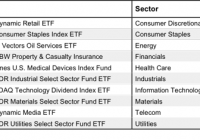ETFs To Hideout In While New Trends Take Shape
Summary Uncertainty in the markets can be a scary thing and often prompt ill-timed moves that set your portfolio back from achieving your goals. The unknown is how long will it take for new opportunities to develop and where the most rewarding setups may ultimately materialize. You may be better off seeking out conservative strategies that give you some measure of correlation to stock or bonds. Uncertainty in the markets can be a scary thing and often prompt ill-timed moves that set your portfolio back from achieving your goals. The initial days of trading in 2015 have certainly shown an increase in volatility that may prove to setup new trends in the near future. The SPDR S&P 500 Trust ETF (NYSEARCA: SPY ) is more than 4% off its all-time highs and initiating the worst start to a New Year since 2008. The unknown is how long will it take for new opportunities to develop and where the most rewarding setups may ultimately materialize. Patience and discipline may be your best allies when stalking new trends. Instead of just languishing in cash that is paying nothing, you may be better off seeking out conservative strategies that give you some measure of correlation to stock or bonds. These short-term holdings using diversified ETFs that will give you the opportunity for some income , capital appreciation, or both. Short Term Bonds Investors that favor short-term bond ETFs as temporary hideouts may want to check out the iShares 1-3 Year Credit Bond ETF (NYSEARCA: CSJ ) or the Vanguard Short-Term Bond ETF (NYSEARCA: BSV ). CSJ is made up of over 900 investment grade credit securities from both domestic and foreign issuers with an effective duration of less than 2 years. The fund has a yield of approximately 1% and charges an expense ratio of just 0.20%. In addition, the net asset value has been very stable over the last several years. BSV has a similar yield with more government related fixed-income and a slightly higher duration as well. Depending on your broker, you may be able to purchase one or both of these ETFs commission-free in order to be able to trade in or out when needed without eating into income or principal. Asset Allocation Funds If you are looking for a fund that is designed to take less risk than the overall market, you may want to consider an asset allocation fund such as the iShares Conservative Allocation ETF (NYSEARCA: AOK ). This ETF takes a “fund of funds” approach to allocate among stocks, bonds, and cash with the goal being low volatility. AOK is primarily weighted towards investment grade bonds with some select domestic and foreign equities. This provides conservative market correlation with a decent 2% yield. Income is paid on a monthly basis, which is an attractive quality as well. Another new entrant in the asset allocation space with more international exposure is the Cambria Global Asset Allocation ETF (NYSEARCA: GAA ). This ETF is unique in that it takes wider exposure to global asset classes and doesn’t charge an overriding management fee. The fund is currently weighted with 50% bond exposure, 43% stocks, and 7% commodities. GAA can provide heavy diversification in a single low-cost investment vehicle . What’s not to like? The Bottom Line Implementing a plan to navigate a market crossroads, while avoiding too much risk, can be a prudent portfolio management technique for most investors. Having too much cash for long periods of time can breed indecision and lead to a state of paralysis. With these ETFs you can still enjoy some participation in market dynamics with less overall exposure to draw down than a traditional equity or bond fund. They can ultimately be a stepping stone to a more conventional trend or strategy when conditions prove to be more favorable. Additional disclosure: David Fabian, FMD Capital Management, and/or clients may hold positions in the ETFs and mutual funds mentioned above. The commentary does not constitute individualized investment advice. The opinions offered herein are not personalized recommendations to buy, sell, or hold securities.
